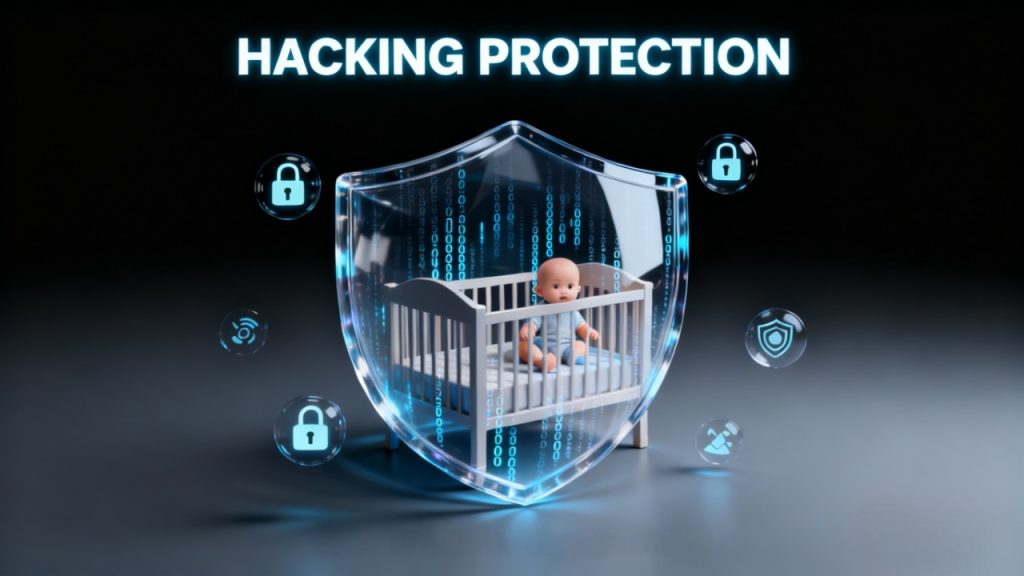Introduction
As smart home technology continues to evolve, more parents are turning to Wi-Fi-enabled baby monitors for real-time video, two-way audio, and app-based alerts. These devices offer incredible convenience — but a growing number of security experts and parents are raising serious privacy concerns. In this post, we well explore why Wi-Fi baby monitors are increasingly targeted by hackers, real-life risks, and practical steps you can take to keep your family safe.

Why Security Risks Around Wi-Fi Baby Monitors Are Trending
1.Increased Connectivity Means Increased Risk
Smart baby monitors are no longer just audio devices. Many now come with HD video, motion sensors, temperature tracking, and more, and connect directly to your home network and smartphone.
2.Cybersecurity Vulnerabilities Are Real
As these devices become more common, so do reports of unauthorized access. Because Wi-Fi baby monitors rely on network connections, they can be hacked if security isn’t tight.
3.Parents Growing Anxiety About Privacy
Stories are circulating of strangers talking to babies over compromised monitors. These fears are compounded by news coverage and social media discussions, prompting many to rethink their choices.
4.Regulatory Pressure Is Mounting
As these devices proliferate, regulators are pushing for stronger security standards. Manufacturers are now incentivized (and sometimes required) to improve encryption, authentication, and firmware safeguards.
5.Market Growth Reflects These Trends
The global baby monitor market is booming, especially for smart, connected models.But with that growth comes greater scrutiny — particularly around data privacy.
Real-Life Incidents That Highlight the Risk
- A mother reported hearing a stranger voice talking through her Wi-Fi baby monitor. She realized someone had been accessing the camera for days.
- According to security experts, many baby monitors ship with default or easily guessed passwords, making them easy targets.
- On Reddit, new parents have shared horror stories of monitors failing or being too unreliable, leading to emotional stress and safety concerns.

How to Choose a Safer Baby Monitor: Expert Tips
If you’re worried about the security of your baby monitor, here are concrete steps to reduce risk while still benefiting from smart features:
1.Use Strong, Unique Passwords
When you first set up your monitor, change the default login credentials immediately.
Use a complex password (mix of letters, numbers, symbols).
Avoid reusing passwords across devices.
2.Enable Encryption & Use Secure Networks
Make sure your home Wi-Fi uses WPA2 or WPA3 encryption. Experts recommend this.
If possible, isolate baby monitor devices on a separate network or VLAN (network segmentation) so a compromised device doesn’t grant access to your entire home.
3.Keep Firmware Updated
Check regularly for software and firmware updates from the monitor manufacturer.
Updates often patch critical security vulnerabilities, so applying them promptly is very important.
4.Consider Monitors with Local-Only Video Feeds
Some monitors don’t rely on cloud or internet connections, instead streaming video locally over a closed (non-internet) signal.
These can significantly reduce hacking risk because they don’t expose their stream to the public internet.
5.Use Multi-Factor Authentication (MFA)
If your monitor app supports it, require an additional verification step (like SMS or authenticator app) whenever someone logs in.
6.Limit Remote Access
Only enable remote viewing when you really need it.
Restrict “always-on” remote access, especially on devices shared by multiple household members.
7.Check Manufacturer Security Practices
Research how the company handles data security: do they encrypt video, do they store data in the cloud, how long is data retained?
Prefer brands that explicitly market their security (“encrypted feed,” “secure connection,” etc.)
Emerging Trends That Could Make Baby Monitors Safer
- AI & Advanced Sensing: New monitors are using AI to analyze baby breathing, movement, and even detect types of crying — reducing the need for constant human monitoring.
- Smart Home Integration: Some baby monitors now connect seamlessly with voice assistants (e.g., Google Home, Alexa), letting parents control them via voice.
- Failsafe Connectivity: Companies like Harbor are designing monitors that can switch between Wi-Fi and radio links so they stay online even when the internet goes down.
- Regulatory Standards: As smart baby monitors grow more popular, regulatory frameworks are emerging that require better encryption, data protection, and security certifications.
Conclusion
Wi-Fi baby monitors offer an unmatched level of convenience, but their benefits come with real security risks. As a parent, staying informed about these vulnerabilities isn’t just smart — it’s essential. By taking steps like securing your network, updating firmware, and choosing devices with strong privacy features, you can enjoy the peace of mind these gadgets promise without exposing your family to unwanted risk.

